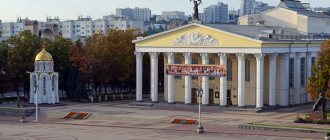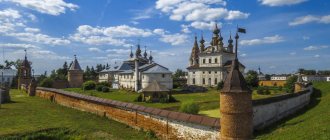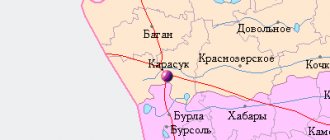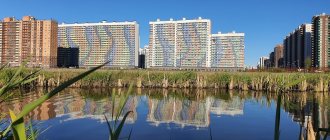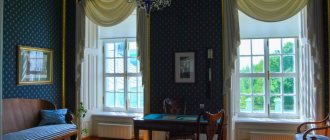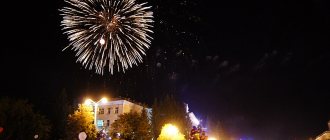The region, which is considered agricultural, is sometimes seen as an eco-tourism center. The historical monuments of the Belgorod region are so interesting that they can attract tourists from all over Russia. Moreover, ethnotourism can be developed here to introduce travelers to the culture and customs of the region. Finally, there are also interesting natural places. In short, you just need to draw up your travel route in advance and mark on the map all the destinations you plan to visit.
Content
- 1 Belgorod is a city of military glory.
- 2 Victory Park
- 3 Monument (bust) “Marshal G.K. Zhukov"
- 4 Alley of Memory of Heroes
- 5 Belgorod State Historical and Art Museum-Diorama “Battle of Kursk. Belgorod direction".
- 6 Architectural structure “For the Fallen in Afghanistan.”
- 7 Monument “Army General I.R. Apanasenko"
Belgorod is a city of military glory.
Belgorod
– our small Motherland, rich in its heroic past.
View of the city
Since ancient times, Belgorod has been a warrior city, a reliable outpost on the southern borders of Russia, defending the Russian land from enemy hordes.
During the harsh years of the Great Patriotic War, the southern face of the Kursk Bulge passed here, where one of the decisive battles of the Second World War took place.
Half of Russia fought here... So many of our people died here. The color of the nation, its pride, glory and future.
The Battle of Kursk, in which almost 4 million people, 13 thousand tanks and self-propelled guns, 12 thousand aircraft and tens of thousands of guns and mortars took part on both sides, ended in the defeat of the German troops. This was a radical turning point in the course of the war. The strategic initiative finally passed into the hands of the Red Army. After it, our troops began to advance and “drive” the enemy all the way to Berlin.
August 5, 1943
Soviet troops recaptured the cities of Orel and Belgorod from the enemy. On this day, in the sky above the capital, Muscovites saw volleys of festive fireworks for the first time in the entire war.
In this regard, the poet Alexander Tvardovsky wrote:
“And the voice of festive guns In the hearts of excited people Was an echo of menacing everyday life, Was the thunder of our batteries. And every house, and alley, And with every stone, all of Moscow Recognized words in these rumbles - Orel and Belgorod. So Belgorod
became the city
of the First Salyut
Salyut
Therefore, many streets, parks, squares, squares and monuments of the regional center are associated with the victory in the Great Patriotic War and the names of those heroes who courageously fought to liberate Belgorod from the fascist invaders. These monuments, museums, and architectural structures are designed to convey the people's grief and inescapable sadness for the dead, as well as eternal gratitude to them and the bright memory of their descendants.
“...Years have passed.
The fighting began. Neighborhoods have already grown. And in honor of the living soldiers, and those who fell, and defended our Belgorod in battles, they named the streets at the former frontier.” L. Kuzubov
Monuments of history and culture
MEMORABLE OBJECTS
Bust of Army General N.F. Vatutina The monument was erected at the intersection of Vatutina Avenue and Korolev Street. Opened on May 6, 1965. Nikolai Fedorovich Vatutin (1901–1944) - Soviet military leader, army general, Hero of the Soviet Union, native of the village of Chepukhino, Voronezh province (now the village of Vatutino, Valuysky district, Belgorod region). Participated in the Civil War. During the Great Patriotic War he was chief of staff of the North-Western Front, commanded the Voronezh, South-Western, and 1st Ukrainian fronts. During the Battle of Kursk, he commanded the troops of the Voronezh Front and took a direct part in the development of the Kursk strategic defensive operation. In February 1943 he was wounded and died on April 15 in a Kiev military hospital. In 1965, N.F. Vatutin was posthumously awarded the title of Hero of the Soviet Union.
Monument to M.S. Shchepkin The monument was erected near the building of the Belgorod State Academic Drama Theater named after M.S. Shchepkina in 1998. Initially, in 1988, the monument was erected near the Smolensk Cathedral, in honor of the 200th anniversary of the actor’s birth. Ten years later, it was moved and installed near the theater that bears his name. Shchepkin Mikhail Semenovich (1788–1863) - an outstanding Russian actor, the founder of realism in Russian stage art, a native of the village. Krasnoye, Kursk province (now the village of Krasnoye, Yakovlevsky district, Belgorod region). The authors of the monument are sculptors V.M. Klykov, A.A. Shishkov, architect S. M. Mikhalev.
Monument to S.A. Degtyarev Monument is located on Grazhdansky Avenue in front of the building of the Music College named after. S.A. Degtyarev Belgorod State Institute of Arts and Culture. Opened in 1994. Stepan Anikievich Degtyarev (1766–1813) is a famous Russian composer, conductor and vocalist, a native of the Borisovka settlement, Belgorod province. The authors of the monument are sculptors A.S. Smely, M.A. Bold, architects V.V. Pertsev, Yu.A. Veretelnikov.
Monument to those killed in Afghanistan The monument is located on the Museum Square of the city of Belgorod between the Belgorod State Museum of History and Local Lore and the Belgorod State Historical and Art Museum-Diorama “Battle of Kursk. Belgorod direction". Opened on February 18, 1995. The monument perpetuates the memory of Belgorod residents who died in Afghanistan between 1979 and 1989. The authors of the sculptural composition are sculptor A.A. Shishkov, architect V.M. Galai.
Monument to the Holy Equal-to-the-Apostles Prince Vladimir - the Baptist of Russia. Located on Kharkov Mountain next to the highway connecting the left and right banks of the Seversky Donets. Opened on August 4, 1998. Vladimir Svyatoslavich (960–1015) - Prince of Novgorod, Prince of Kiev, under whom the Baptism of Rus' took place. The monument is made of copper using the knockout technique at the Kaluga Sculpture Factory. Consists of three pictorial tiers. The lower one is formed by four six-figure reliefs (24 figures in total), the second - by three single-figure reliefs, and on the third tier there is a figure of Prince Vladimir. The height of the monument from the surface of the earth is 22.5 meters, of which 15 meters is the pedestal and 7.5 meters is the sculpture of Prince Vladimir. The authors of the monument are sculptor V.M. Klykov, architect V.V. Pertsev.
Monument to the “Victims of Chernobyl” The monument is located on B. Khmelnitsky Avenue, next to the Belgorod Industrial College. The monument was erected in 1998 in memory of Belgorod residents - liquidators of the consequences of the Chernobyl nuclear power plant accident in 1986. The author of the monument is sculptor A.A. Shishkov.
Bust of Marshal I.S. Konev The monument was erected in Belgorod on I.S. Konev Street in 1998. Ivan Stepanovich Konev (1897 - 1973) - an outstanding military leader, Marshal of the Soviet Union, twice Hero of the Soviet Union. In July 1943, I.S. Konev commanded the troops of the Steppe Front, at the head of which he managed to achieve success in the Battle of Kursk, in the Belgorod-Kharkov strategic offensive operation “Rumyantsev” and in the battle for the Dnieper. In August 1943, the troops of the Steppe Front under the command of I.S. Konev was released from Belgorod. The author of the monument is sculptor A.S. Brave.
Chapel-rotunda in honor of the 2000th anniversary of the Nativity of Christ The chapel-rotunda was erected at the northern entrance to the city of Belgorod on the Moscow-Simferopol highway. Opened and dedicated on January 7, 2000. Inside the rotunda there is a statue of an angel who “meets and blesses” everyone entering the city. The authors of the project are architect A.N. Bersenev, sculptor A.A. Shishkov.
Alley of Heroes of the Soviet Union and Heroes of Russia Alley of Heroes in Victory Park in Belgorod was opened and consecrated on May 8, 2001. On the alley there are busts of 18 Heroes of the Soviet Union and 5 Heroes of Russia from Belgorod: - Hero of Russia Burtsev V.V. (2001, author – sculptor D.F. Gorin); — Hero of the Soviet Union Limansky K.A. (2001, author - sculptor A.S. Smely); — Hero of the Soviet Union Tyusin N.M. (2001, author – sculptor A.A. Pshenichny); — Hero of the Soviet Union Khromykh V.P. (2001, author - sculptor M.A. Smely); — Hero of the Soviet Union Tikhonov N.I. (2001, author - sculptor M.A. Smely); — Hero of the Soviet Union Orlov A.I. (2001, author – sculptor D.F. Gorin); — Hero of the Soviet Union Lukinova N.T. (2001, author – sculptor A.A. Pshenichny); — Hero of the Soviet Union Kramchaninov I.P. (2001, author - sculptor A.A. Shishkov); — Hero of the Soviet Union P.P. Zyubin. (2001, author - sculptor A.A. Shishkov); — Hero of the Soviet Union Kononenko N.N. (2001, author - sculptor A.S. Smely); — Hero of the Soviet Union Denisov V.N. (2001, author - sculptor A.A. Shishkov); — Hero of the Soviet Union Besedin N.F. (2001, author - sculptor A.A. Shishkov); — Hero of Russia Zuev D.S. (2002, author - sculptor A.S. Smely); — Hero of the Soviet Union Gostishchev P.M. (2002, author - sculptor D.F. Gorin); — Hero of the Soviet Union Mazikin E.I. (2002, author - sculptor M.A. Smely); — Hero of the Soviet Union Moskalev D.E. (2002, author - sculptor D.F. Gorin); — Hero of the Soviet Union Filatov V.R. (2002, author – sculptor A.A. Pshenichny); — Hero of the Soviet Union Trainin P.A. (2005, author – sculptor O.N. Trofimenko); — Hero of Russia Barkovsky V.B. (2005, author - A.S. Smely); - Hero of the Soviet Union Shelomtsev N.G., (2008, author - sculptor A.A. Pshenichny); — Hero of the Soviet Union Levin G.T. (2009, author – sculptor M.A. Smely); — Hero of Russia Chumak Yu.A. (2017, author – sculptor O.N. Trofimenko); — Hero of Russia Vornovsky Yu.V. (2017, author – sculptor D.F. Gorin); The Alley of Heroes is completed by a bust of four times Hero of the Soviet Union, Marshal of the Soviet Union G.K. Zhukova. The bust was installed in 1998. The author of the bust is G.K. Zhukova - sculptor D.F. Gorin.
Monument to Saint Joasaph of Belgorod The monument to the heavenly patron of the Holy Belogorie, Saint Joasaph, was installed on the Holy Trinity Boulevard near the Marfo-Mariinsky Monastery. Joasaaf of Belgorod (Joakim Andreevich Gorlenko) (1705–1754) - bishop of the Russian Orthodox Church, bishop of Belgorod and Oboyansky. In 1911 he was canonized as a hierarch of the Russian Orthodox Church. The author of the monument is sculptor A. Shishkov.
Monument to engineer V.G. Shukhov The monument was erected on the territory of the Belgorod State Technological University. V.G. Shukhova. Opened in 2001. Vladimir Grigorievich Shukhov (1853–1939) - Russian, Soviet engineer, architect, inventor, scientist; corresponding member and honorary member of the USSR Academy of Sciences, laureate of the V.I. Lenin Prize, Hero of Labor, native of the city of Grayvoron, Belgorod region. He is the author of projects for the first Russian oil pipelines and an oil refinery with the first Russian oil cracking units. He made outstanding contributions to the technology of the oil industry and pipeline transport. V.G. Shukhov was the first in the world to use steel mesh shells for the construction of buildings and towers, and also introduced the form of a single-sheet hyperboloid of rotation into architecture, creating the world's first hyperboloid structures. The authors of the monument are sculptor A.A. Shishkov and architect V.V. Pertsev.
Bust of S.S. Kosenkov Bust of S.S. Kosenkov was installed near the building of the socio-theological faculty named after Metropolitan Macarius (Bulgakov) of Moscow and Kolomna at Belgorod State National Research University in 2005. Stanislav Stepanovich Kosenkov (1941–1993) - an outstanding graphic artist, Honored Artist of the RSFSR, author of illustrations for the works of famous Russian poets and writers, a native of the Prokhorovsky district of the Belgorod region. For a series of works for “Crime and Punishment” by F. M. Dostoevsky, consisting of 47 illustrations, S. S. Kosenkov received two gold medals at international book art competitions in Germany and Czechoslovakia. The author of the bust is sculptor A. A. Shishkov.
Monument to police captain F.S. Khikhlushka The monument was erected on the territory of the Municipal Budgetary Educational Institution “Gymnasium No. 12” (Khikhlushka St., 4) in 2010. Fedor Semenovich Khikhlushka (1926–1966) - Belgorod police dog handler died while apprehending a dangerous criminal on April 7, 1966. By decree of the Presidium of the Supreme Soviet of the USSR, police captain Fyodor Semyonovich Khikhlushka was awarded the Order of the Red Star (posthumously) for courage and heroism shown in the line of duty. The author of the monument is sculptor O.O. Kyiv.
Memorial composition in memory of victims of political repression. The monument was erected in the Memory Park in 2011. The monument perpetuates the memory of victims of political repression from the late 1920s to 1953. The team of authors is architects O.M. Donchenko N.A. Timonov, sculptors A.A. Shishkov and T.V. Kostenko.
Monument to I.A. Bunin The monument was installed in front of the central building of the Belgorod State National Research University on the street. Student in 2011. Ivan Alekseevich Bunin (1870 - 1953) - famous writer and poet, the first Russian winner of the Nobel Prize in Literature, academician of the St. Petersburg Academy of Sciences. He spent many years of his life in exile, becoming one of the main writers of the Russian diaspora. The author of the monument is sculptor A.A. Shishkov.
Bust of the first Belgorod governor, Prince Yu.Yu. Trubetskoy The monument is located at the intersection of Prince Trubetskoy Street and Narodny Boulevard. Opened on August 2, 2012. Prince Yuri Yuryevich Trubetskoy (1668–1739) - Russian statesman, actual privy councilor, senator, first Belgorod governor (1727–1730). Under Yuri Trubetskoy in 1730, the coat of arms of the Belgorod province was approved. The authors of the monument are sculptor O.N. Trofimenko, architect M.A. Khromov.
Monument to M.A. to Sholokhov was erected in front of the central building of the Belgorod State National Research University on the street. Student in 2012. Mikhail Aleksandrovich Sholokhov (1905 – 1984) – Soviet writer, winner of the Nobel Prize in Literature, author of such famous works as “Quiet Don” and “Virgin Soil Upturned”. The author of the monument is sculptor A.A. Shishkov.
Monument to A.I. Solzhenitsyn The monument was erected in front of the central building of the Belgorod State National Research University on the street. Student in 2012. Alexander Isaevich Solzhenitsyn (1918 – 2008) - famous Soviet writer, historian, public and political figure, member of the Russian Academy of Sciences, dissident. Nobel laureate, author of the famous manuscript “The Gulag Archipelago”. The author of the monument is sculptor A.A. Shishkov.
Stela “City of Military Glory” Stela “City of Military Glory” was installed on Cathedral Square in the city of Belgorod. The grand opening of the stele took place in 2013, the year of the 70th anniversary of the liberation of Belgorod from fascist invaders. By Decree of the President of the Russian Federation dated April 27, 2007 No. 558, for the courage, fortitude and mass heroism shown by the city’s defenders in the struggle for freedom and independence of the Fatherland, the city of Belgorod was awarded the honorary title of the Russian Federation “City of Military Glory.” The monument is a single composition of several architectural elements. The central element of the composition is a column made of a single piece of granite, topped with an armorial eagle. Around the column, at the corners of the stylobate, there are massive stone blocks on which artistic reliefs are placed, depicting the main milestones of the city’s military history. Team of authors: Authors of the typical recommended composition: I.N. Voskresensky, G.A. Ishkildina, V.V. Perfilyev, S.A. Shcherbakov. Architects of binding and adaptation of the standard composition - V.V. Pertsev, V.A. Turchenko, O.V. Mazdic. Project architects (individualization and landscape design) – I.N. Voskresensky, V.V. Perfilyev Project sculptor (thematic reliefs) – S.A. Shcherbakov.
Monument to B.L. Pasternak The monument was erected in front of the central building of the Belgorod State National Research University on the street. Student in 2014. Pasternak Boris Leonidovich (1890–1960) is a Russian writer and one of the greatest poets of the 20th century. Author of the famous novel "Doctor Zhivago", many translations from other languages, collections of poems, stories, articles and essays. Winner of the Nobel Prize in Literature "For significant achievements in modern lyric poetry, as well as for continuing the traditions of the great Russian epic novel." The author of the monument is sculptor A.A. Shishkov.
Monument to Bohdan Khmelnitsky The monument was erected on Holy Trinity Boulevard in 2014.
Khmelnytsky Bohdan (Zinovy) Mikhailovich (1595–1657) - hetman of the Zaporozhian Army, commander and statesman, organizer and ideological leader of the uprising of the Zaporozhye Cossacks against the rule of the Polish-Lithuanian Commonwealth, the result of which, after a nine-year struggle, was the founding of a new state formation - the Zaporozhye Army, which existed until the end XVIII century. The author of the monument is sculptor A.I. Lokhtachev.
Monument to Sergius of Radonezh The monument to Sergius of Radonezh was erected at the intersection of Slavy Ave. and st. Prince Trubetskoy in 2014, in the year of celebrating the 700th anniversary of St. Sergius of Radonezh. Sergius of Radonezh (1314–1392) - monk of the Russian Church, founder of the Trinity Monastery near Moscow (now the Trinity-Sergius Lavra), transformer of monasticism in Northern Rus', is revered by the Russian Orthodox Church as a saint, considered the greatest ascetic of the Russian land. The author of the monument is sculptor A.I. Lokhtachev.
Monument to participants in local wars and armed conflicts. The monument was erected on the city’s Museum Square in 2014. It perpetuates the memory of our fellow countrymen, participants in local wars and armed conflicts. 3,219 Belgorod residents took part in local wars and armed conflicts in the 20th and early 21st centuries on the territory of 24 states, 64 of whom died. The preliminary design of the monument was proposed by the Belgorod regional branch of the All-Russian public organization of veterans “Combat Brotherhood”.
Monument to I.A. Brodsky The monument was erected in front of the central building of the Belgorod State National Research University on the street. Student in 2015. Joseph Aleksandrovich Brodsky (1940–1996) - Russian and American poet, writer, essayist, playwright, translator, teacher, Nobel Prize laureate in literature. The author of the monument is sculptor A.A. Shishkov.
Monument to I.D. Putilin The monument was erected on the territory of the Belgorod Law Institute of the Ministry of Internal Affairs of Russia in 2015. Ivan Dmitrievich Putilin (1830–1893) is a famous Russian detective, an outstanding police officer with high ethical principles, a native of Novy Oskol, Belgorod region. The author of the monument is sculptor A.A. Shishkov.
Monument to “Citizens who did not return from the war” The monument is located on the territory of the old city cemetery (Popova St.). The grand opening of the monument took place on August 5, 2015. The monument perpetuates the memory of residents of the city of Belgorod who died on the fronts of the Great Patriotic War. Natives of the city and the Belgorod region fought on all fronts of the Great Patriotic War, showing examples of courage and bravery. Soldiers of the 299th Rifle Division, formed on the territory of the city of Belgorod, defended Moscow, fought in Stalingrad, and participated in the liberation of Kharkov. For their exploits during the Great Patriotic War, 207 Belgorod residents were awarded the title of Hero of the Soviet Union - the highest insignia of courage and heroism. More than 5 thousand Belgorod residents did not return from the fields of the Great Patriotic War. The author of the monument is sculptor A.I. Lokhtachev.
Monument to Tsar Fyodor Ioannovich The monument was erected on Narodny Boulevard in 2021. Fyodor I Ioannovich (1557–1598) – Tsar of All Rus' and Grand Duke of Moscow (1584–1598), third son of Ivan IV the Terrible, last representative of the Moscow branch of the Rurik dynasty. Canonized by the Orthodox Church as “Holy Righteous Theodore I Ioannovich, Tsar of Moscow.” During the reign of Fyodor Ioannovich, the massive construction of fortified cities began on all the outskirts of the state. Their goal was to more successfully develop new territories and protect the southern borders of the Moscow kingdom. In 1593, the Boyar Duma decided to build the fortified city of Belgorod, and then, probably, a settlement arose on the site of the future city. The second version of the founding date of Belgorod is 1596, as evidenced by the entry in the “Rank Book”. Both versions date back to the reign of Fyodor Ioannovich. The author of the monument is sculptor A.I. Lokhtachev.
Monument to M.M. Speransky The monument was erected on Narodny Boulevard near the building of the Arbitration Court of the Belgorod Region in 2021. Mikhail Mikhailovich Speransky (1772–1839) - Russian public and statesman, reformer, lawmaker. He was the initiator of legal reforms that were of great importance for the historical development of Russia. Under Nicholas I, he led the work on codifying legislation, laying the foundations of theoretical jurisprudence (legal science) in Russia. The author of the monument is sculptor B.I. Sergienko.
Monument to Belgorod sailors The monument was installed on the territory of the Church of St. Righteous John of Kronshtadt (B. Khmelnitsky Ave., 167-a), opened in 2021. He personifies the courage, perseverance and valor of all generations of Belgorod sailors. Authors: sculptor D.F. Gorin and chairman of the Belgorod regional public organization “Maritime Assembly” N.S. Yakubovsky.
Victory Park
The Victory Street located in the center of Belgorod and the adjacent Victory Park, located in a picturesque location on the banks of the Vezelka River, became the symbol of Victory. For the courage and perseverance shown by Belgorod residents during the Great Patriotic War, the city of Belgorod was awarded in 1980 the Order of the Patriotic War, 1st degree.
Order of the Patriotic War, 1st degree
The image of this Decree on the stele precedes the entrance to Victory Park.
The monument “Victory in the Patriotic War” Victory Park
is dedicated to the city of the first salute
Elevation 123 50°35.547′ N. w. 36°35.116′ E. d. (G)
The main monument on the central alley of Victory Park is the “Victory in the Patriotic War” monument, created by Moscow sculptor V. Chukharkin.
This sculptural composition with an all-round view was installed in 1983, the year of the 40th anniversary of the Battle of Kursk and the liberation of Belgorod from the Nazi invaders. The central figure of this composition is a female soldier, with her arms raised, holding the pole of a banner raging in the wind with her left hand, and a small bouquet of flowers with her right hand. On the left side of her, a young soldier raised his machine gun, as if symbolizing the victory of Russian weapons. On the right side, an elderly mustachioed soldier also raised a machine gun in his right hand, and with his left hand, calmly lowered down, he holds the fluttering raincoat.
The “rhythm” of the wind in the sign and in the cloak-tent add dynamism to this composition, which stands on a low hexagonal pedestal lined with red granite tiles.
In general, this monument eloquently tells descendants that victory in the war with a terrible enemy was achieved primarily because both young and old, women and old men, rose up to defend the Motherland, ensuring a truly national character for this war.
Monument (bust) “Marshal G.K. Zhukov"
Marshall G.K.
Zhukov Vys 117 50°35.510′ s. w. 36°35.069′ E. d. (G)
The central place in the Victory Park of Belgorod is rightfully occupied by the bust of Marshal of the Soviet Union Georgy Konstantinovich Zhukov, created by the architect Yu. Veretelnikov and the sculptor D. Gorin.
On August 5, 1998, the opening of this monument took place, the authors of which sculpted a realistic image of the famous commander. The authors expressed the greatness of the commander with the traditional monumental design of the architectural and sculptural part of the monument, so it organically fit into the environment of the main alley of the park. Historical reference.
G.K. Zhukov
- the most gifted, original, outstanding commander of the Great Patriotic War and the entire Second World War.
The main thing that characterizes his military leadership is the greatness of the victories he won. The most important of them: Khalkhin Gol, Yelnya, defense of Leningrad and Moscow, Stalingrad, Battle of Kursk, Kiev, Korsun-Shevchenko, Belarusian, Vistula-Oder and Berlin operations. Each of the studies conducted by G.K. Zhukov's operations were distinguished by their originality, the novelty of the actions taken and therefore turned out to be unexpected for the enemy. This is important to know.
G.K. Zhukov
, who made a great contribution to the victory at Kursk and to the definition of a deliberate defense strategy, is an honorary citizen of Belgorod. This is what he answered to a question from a special correspondent of Komsomolskaya Pravda about the distinctive feature of the Battle of Kursk from all previous battles.
G.K. Zhukov:
“The Battle of Kursk was distinguished by its deliberateness. Both sides prepared for the battle in advance and for a long time. The Germans believed that we had no idea about their plan. They were wrong. After a thorough analysis of the strategic situation and a lot of data obtained by front-line and human intelligence, we came to a unanimous opinion: on the Kursk Bulge, the Germans want to take revenge for the Stalingrad defeat. But, having guessed the plans of the German command, we did not shy away from the place he had chosen for the battle. We had some disagreements on only one point: to defend ourselves or, choosing the time, to launch a pre-emptive strike? After carefully discussing everything, we decided that a strong, deep (up to 300 kilometers) defense would be more profitable. Bleed the enemy and then go on the offensive with all your might.”
Alley of Memory of Heroes
Victory Park
Alley of Heroes
Altitude 122 50°35.500′ N. w. 36°35.132′ E. d. (G)
The memory of the hero-liberators, of those who gave their lives for the liberation of the Belgorod region and other territories of the country from the Nazi invaders, of the Heroes of the Soviet Union and Heroes of Russia - Belgorod residents - is immortalized in the Alley of Memory of Heroes in Victory Park. The alley was inaugurated on May 9, 2000. 12 metal busts of Belgorod Heroes of the Soviet Union and Russia were installed on granite pedestals. V.V. Burtsev and A.I. Orlov (author of the busts, sculptor D. Gorin), N.T. Lukinov and N.I. Tyusin (author of the busts, sculptor A. Pshenichny), N.N. Kononenko and K.A. Limansky (author of the busts, sculptor A. Smely), N.N. Tikhonov and V.P. Khromykh (author of the busts, sculptor M. Smely), N.F. Besedin, V.N. Denisov, P.P. Zyubin and N.P. Kramchaninov (author of the busts, sculptor A. Shishkov). The author of the project for the Avenue of Heroes is the architect V. Salonnik. The presence of individuality in the handwriting of different sculptors introduced an interesting variety of characters in the artistic images of the busts they created.
Bohdan Khmelnitsky Oak
This is a natural monument of its own, and at the same time it can be considered a historical landmark. Dendrologists estimate that the oak was planted more than 300 years ago. Legend claims that he was landed by Prince Gregory Romodanovsky and Ukrainian Hetman Bohdan Khmelnytsky to commemorate the reunification of the two countries. Today, this relict spreading tree still symbolizes the unity of the two Slavic peoples.
This oak is located on the territory of the village of Dubovoe, near the temple of the icon of the Mother of God “Control of the Loaves”. It is popular with newlyweds, who arrange photo sessions here and hang locks on a chain entwined around a mighty oak tree (its trunk diameter is more than 5 meters). The relict tree is protected by the state.
However, this is not the only long-liver in the region. Between the villages of Yablochkovo and Dmitrievka, in the Shebekinsky district, there grows a unique Pansky oak, whose age is 550 years old, according to dendrologists. They say that Peter the Great himself stayed here when returning from the Battle of Poltava. The height of the tree is 35 m, and the girth of the trunk exceeds 5 m.
Architectural structure “For the Fallen in Afghanistan.”
Popova Street, Belgorod
- View 1
- View 2
- View 3
Altitude 112 50°35.505′ N. w. 36°35.334′ E. d. (G)
The author of the architectural structure “Fallen in Afghanistan” is local sculptor A. Shishkov. On February 14, 1997, its grand opening took place next to Victory Park in Belgorod at a rally dedicated to the eighth anniversary of the withdrawal of troops from the Democratic Republic of Afghanistan.
Valery Varganov recalls: “The cold and piercing wind chilled more than two thousand of the townspeople present to the very bones; the unseasonably drizzling rain forced them to wrap themselves more and more tightly in their clothes. The delegation from the regions, who arrived by bus, immediately merged with their frozen fellow countrymen. The head of Belgorod local government, Georgy Golikov, opens the rally. For a long, very long time, his father Viktor Nikolaevich Kholintov remembers his deceased son, trembling in his voice. Words of gratitude... Music suddenly sounds loud... Carnations, roses... Dozens of hands carry them to the crucifix. Powerfully, from the secret depths of consciousness, sweeping away everything in its path, the lines break out: “Flowers lie like tears on granite slabs...”.
For Belgorod residents, this monument has become a symbol of heroism, military valor, friendship, loyalty to the oath and eternal memory.
“Dedicated to the memory of those fallen in Afghanistan” read the lines on the architectural composition, which includes memory bells and a Christian cross, overshadowing all the Belgorod residents who died in the hostilities of 1979-1989. on Afghan soil. “Greater love has no one than this, that a man lay down his life for his friends,” is inscribed on the cross. Four memorial plaques bear the names of Belgorod soldiers who died while performing their international duty in Afghanistan.
Historical reference.
During the ten years of the war in Afghanistan, 3,382 Belgorod residents took part in hostilities, 85 did not return home, dying with honor and dignity, one went missing, 746 people were awarded orders and medals. On February 15, 1989, the last units of the limited continent of Soviet troops in Afghanistan left the rebellious country. But the terrible lessons of the bloody war still resonate with pain in our memory. That’s why there are always flowers at the foot of the monument to those who fell in Afghanistan, and every year on the day of remembrance of internationalist soldiers, mourning rallies are held here and wreaths are laid.
Prokhorovskoe field and monastery
It is worth going to the Prokhorovskoe Field Museum-Reserve, whose territory covers several thousand hectares. These are two districts of the region at once - Prokhorovsky and Yakovlevsky, and it is best to travel here by car. The command post of General Rotmistrov has been preserved here, and museums have also been organized in the villages of Yakovlevo and Prokhorovka. It is worth visiting the Church of the Apostles Peter and Paul. On the walls of the building you can read thousands of names of soldiers who died in the great battle.
The Holy Trinity Kholkovsky Cave Monastery is located in the Chernyansky district, about 120 km from Belgorod, near the village of Ezdotskoye. The monastery was carved out of a chalk mountain about 400 years ago, but under Catherine the Great it was abolished and restored only in 1999. Archaeologists have found ancient monastic cells and an underground temple, where services are still held today. Although, of course, the modern monastery is located on the surface of the earth.
